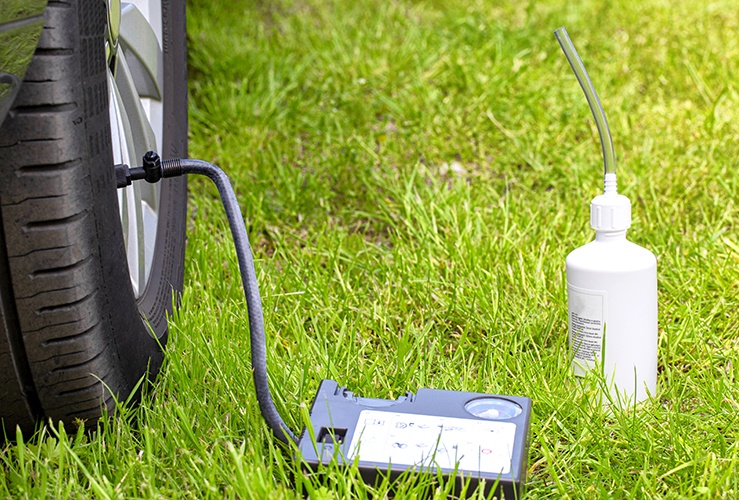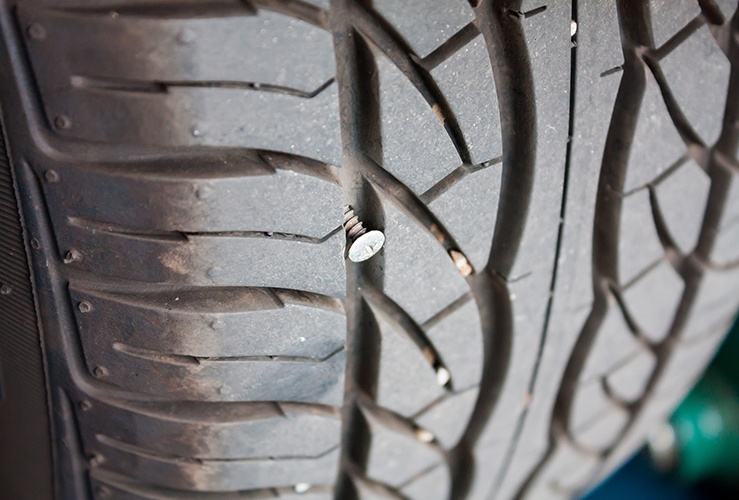Due to a heavy focus on cost- and weight-saving measures, spare tyres are not provided in most new cars. Only about 40% of new vehicles have a spare tyre - once considered an essential back-up item for the average motorist.
If your new car doesn’t have a spare wheel, it will come with a car tyre puncture repair kit instead.
These tyre sealant kits are not terribly popular among drivers, but if you have one, you should know how to use a tyre repair kit
Note: You should always check your vehicle handbook for any fault remedy before carrying out any work on your vehicle. If you are unsure of what is required to fix any problems, please consult a professional.

Can you avoid getting punctures in the first place?
Whilst it is inevitable that some motorists will experience a punctured tyre at some stage during their years of driving, there are some measures that you can take to help prevent punctures occurring in the first place:
- Maintain the correct tyre pressure – Regularly checking your tyre pressure can help prevent your tyres from wearing out prematurely and reduce the risk of a blow out.
- Never over-inflate or under inflate your tyres
- Check your tyres for wear - Worn tyres are more prone to punctures and blow outs so ensure that you regularly check your tyres for signs of wear and check the tread depth of your tyres, replacing them when required.
- Never overload your vehicle - overloading also increases your chances of getting a puncture or a blowout.
- Drive with care - Potholes and debris can cause your vehicle to suffer a puncture. If possible, avoid any such obstructions. If it is too dangerous to manoeuvre to avoid these, adapt your speed accordingly to help minimise likelihood of damage to your tyre.
If you have a tyre puncture…
Once you've detected a puncture, pull over and stop in a safe place - ideally away from traffic.
Apply your handbrake and switch off the engine.
Turn on hazard lights if needed and, if you have one, use a warning triangle.
Get out and examine the puncture.
How effective is a tyre sealant kit?
Your car’s puncture repair kit will only fill holes of about 4 mm in diameter. This means dealing with a nail or screw is fine, but if the tyre is torn or the wheel is damaged, you'll need to call your breakdown recovery provider.
Where is my puncture repair kit?
Your car’s puncture repair kit will be in the boot - either in a side panel or under the boot floor. The kit features a bottle of tyre sealant and a compressor for inflating the tyre.
What if I have a nail in my tyre?
If you have a nail in your tyre, do not attempt to remove it. Instead, unscrew the tyre valve cap and attach the sealant bottle.
Once attached, the sealant will spread around inside the tyre, hopefully sealing any holes.
Next, attach the compressor. This may be fixed through the bottle via a special mechanism, or you may need to remove the bottle and fix it directly to the tyre valve - it depends on your model.
Attach the compressor to your 'cigarette lighter', aka the 12V charge socket. Then turn on the engine and start the compressor. Inflate the tyre to the level recommended in the handbook.
What if the tyre fails to inflate?
If the tyre fails to inflate, roll the car forward to move the tyre foam sealant around.
If this doesn’t work, you may need to call your vehicle recovery service.
If you successfully repair the tyre, you can drive off - but gently and below 50mph. After a couple of miles stop to check your tyre pressure.
Remember this is just a temporary fix. You'll need to get a new tyre - and a new bottle of sealant.

Tubeless tyre repair kit
Tubeless tyre repair kits are not supplied by car makers, but they can be effective in addressing a tyre puncture on a temporary basis. They are designed for objects like nails or screws.
How to use a tubeless tyre repair kit:
- Remove the screw or nail
- Use the provided reamer tool to clean and enlarge the hole
- Move it in and out of the hole - this will take some effort
- Take one of the sticky rubber strips provided
- Feed it halfway through the eye of the strip insertion tool
- Add the provided tube cement to the strip
- Push the strip into the hole - but not all the way in
- Yank out the insertion tool, then cut away excess strips
Again, this is a temporary fix. You’ll still need to buy a new tyre.
How can Start Rescue help with tyre repair?
Whether its UK cover or European, at Start Rescue we provide breakdown recovery coverage to help you with car tyre repairs.
If you don’t have the appropriate equipment to enable us to change or repair your punctured tyre, we will recover you up to 10 miles to enable garage tyre fitters to perform a repair.
As well as giving you the protection you need out on the roads, you’ll find our breakdown cover quotes offer some of the most competitive prices in the market.
Find out more information on what to do if you get a flat car tyre.




